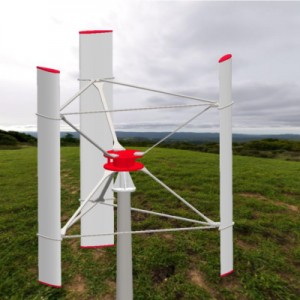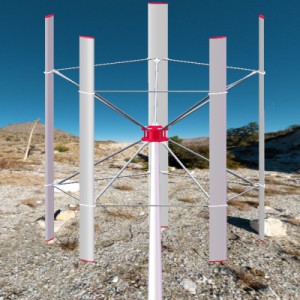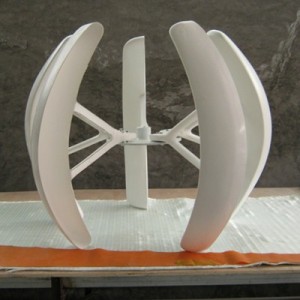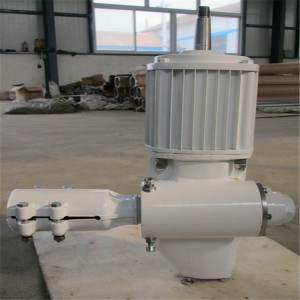Low-density high-strength wind turbine blades
The blade is the most basic and key component of the wind turbine. Its good design, reliable quality and excellent performance are the decisive factors to ensure the normal and stable operation of the unit. The requirements for blades under harsh environment and long-term non-stop operation are as follows:
1. It is light in density and has the best fatigue strength and mechanical properties, and can withstand the test of extreme harsh conditions such as storms and random loads;
2. The elasticity of the blade, inertia during rotation and its vibration frequency characteristic curve are normal, and the load transferred to the whole power generation system is stable. It is not allowed to break and fly out under the action of centrifugal force under the condition of runaway (runaway), or break under the action of wind pressure, or generate strong resonance that causes the whole wind turbine generator unit within the range of runaway speed;
3. The material of the blade must be smooth to reduce the wind resistance, and the rough surface will also be "torn" by the wind;
4. It shall not produce strong electromagnetic wave interference and light reflection;
5. Excessive noise is not allowed;
6. Good corrosion resistance, ultraviolet radiation and lightning resistance;
7. Low cost and lowest maintenance cost.
Basic Requirements
The materials used for processing blades include wood, metal, engineering plastics, glass fiber reinforced plastics, etc.
Wooden blade and cloth skin blade
Modern micro and small wind turbines also use wooden blades, but wooden blades are not easy to be twisted. Large and medium-sized wind turbines rarely use wooden blades, and those that use wooden blades also use integral wooden beams with good strength as blade longitudinal beams to bear the force and bending moment that the blades must bear when working.
Steel beam glass fiber skin blade
In modern times, steel pipe or D-shaped steel was used as longitudinal beam, steel plate as rib beam, and foam plastic was filled inside and glass fiber reinforced plastic skin was covered outside the blade, which is generally used on large wind turbines. The section of the steel pipe and D-shaped steel of the blade longitudinal beam from the blade root to the blade tip should be gradually reduced to meet the requirements of the twisted blade and reduce the weight of the blade, that is, to make the beam of equal strength.
Aluminum alloy extruded blade with equal chord length
The blade with equal chord length formed by aluminum alloy extrusion is easy to manufacture, and can be connected with production, and can be twisted according to the design requirements. The shaft and flange connecting the blade root and hub can be realized by welding or bolt connection. Aluminum alloy blades are light in weight and easy to be processed, but they cannot be gradually shrunk from the blade root to the blade tip, because the world's famous countries have not yet solved this extrusion process. In addition, the oxidation and aging of aluminum alloy materials in the air are also worth studying.
GRP blade
The so-called glass fiber reinforced plastic (GFRP) is a reinforced plastic made of epoxy resin, unsaturated resin and other plastics infiltrated into glass fiber or carbon fiber with different lengths. The reinforced plastic has high strength, light weight and aging resistance. The surface can be wrapped with glass fiber and coated with epoxy resin, and other parts can be filled with foam plastic. The main role of foam in the blade is to reduce the blade quality while ensuring its stability, so that the blade can meet the stiffness while increasing the wind catching area.
Considering the mechanical properties, price and other factors of foam, the foam used as the core material of wind power blade mainly includes PVC, PS, PUR, SAN, PEI and PMI, PET, etc. PVC foam is the most widely used structural foam core material, also known as cross-linked PVC, which is the first structural foam core material used in sandwich structures of load-bearing members. This foam belongs to thermosetting foam, which was invented by German Linderman in the late 1930s.
PET foam (Airex) is a foam developed and produced only in recent years. It belongs to thermoplastic foam. The production process is extrusion foaming, but unlike PS foam, its extrusion width is limited. Therefore, after extrusion, it should be spliced into a larger foam body through hot-melt bonding for use. [1]
The quality of glass fiber can also be improved by surface modification, sizing and coating, and its unit (kW) cost is low.
Carbon fiber composite blade
With the development of wind power generation industry, the requirements for blades are higher and higher. For blades, stiffness is also a very important indicator. The research shows that the stiffness of carbon fiber (CF) composite blades is two to three times that of glass fiber reinforced plastic composite blades. Although the performance of carbon fiber composite is much better than that of glass fiber composite, its high price affects its wide application in wind power generation. Therefore, the major composite material companies in the world are conducting in-depth research from raw materials, process technology, quality control and other aspects in order to reduce costs.
The airfoil of the blade is designed according to the aerodynamic principle and is the decisive factor to determine the efficiency and working condition of the wind turbine.










